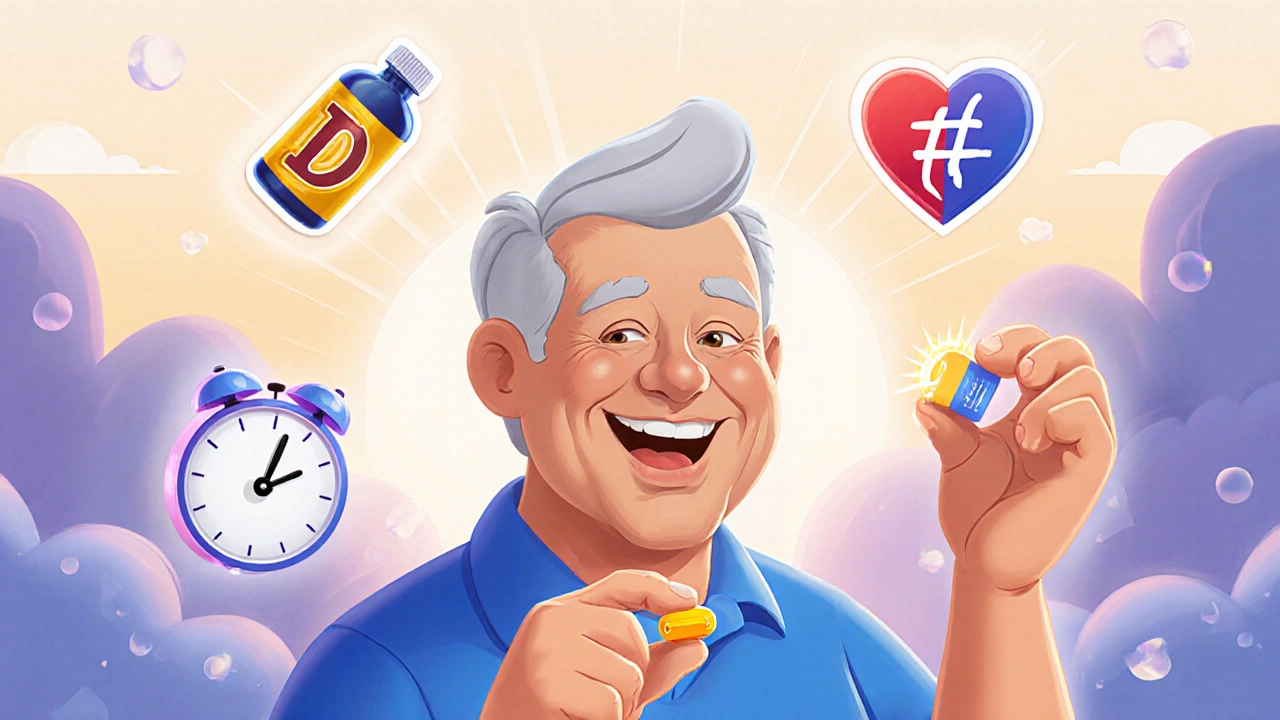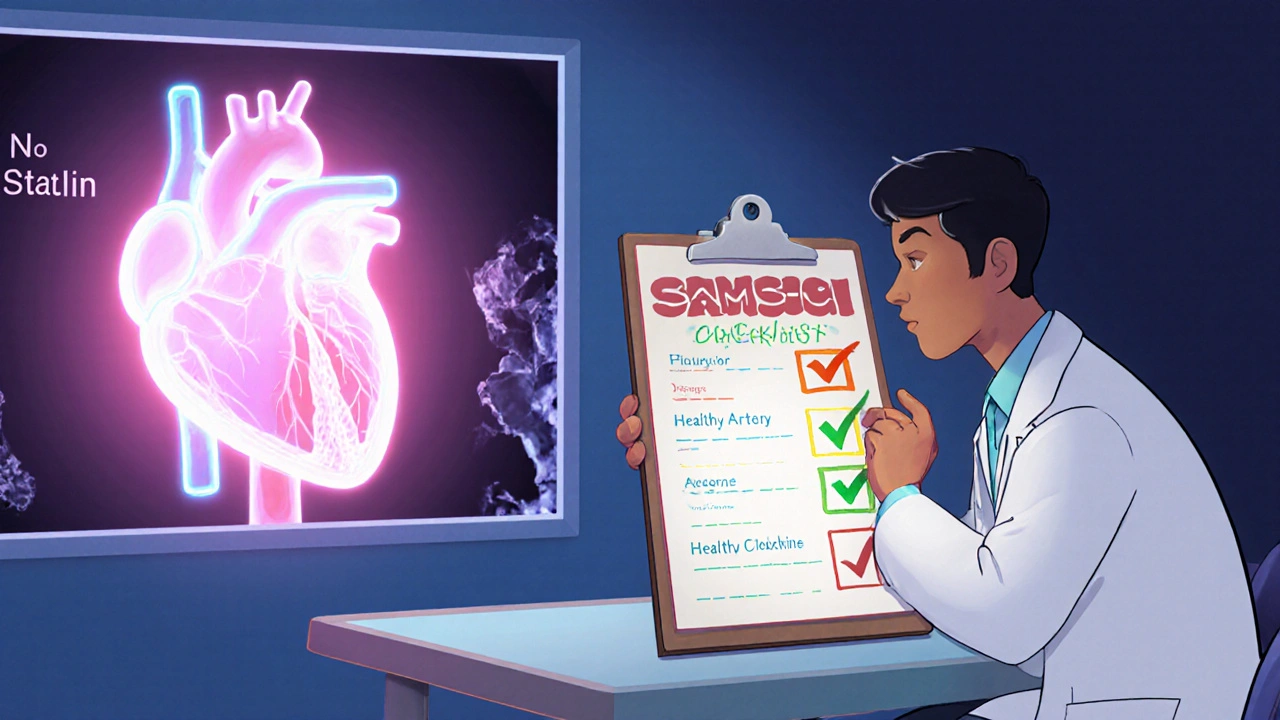Rechallenge After Statin-Induced Myopathy: Safe, Proven Strategies

SAMS-CI Calculator: Are You Statin-Tolerant?
SAMS-CI Assessment
The Stain-Associated Muscle Symptom Clinical Index (SAMS-CI) is a 5-point checklist that determines if your muscle pain is likely caused by statins. This tool helps you make informed decisions about whether to try a statin rechallenge.
Your SAMS-CI Score
Next Steps
Many people stop taking statins because of muscle pain - but stopping might be riskier than staying on them. Statin-induced myopathy isn’t always what it seems. In fact, statin myopathy is often misdiagnosed. Studies show that in double-blind trials, about 5% of people on statins report muscle pain - and so do about 5% of people on placebo. That means for most, the pain isn’t caused by the drug. It’s the nocebo effect: the fear of side effects makes you feel them.
When to Try Rechallenge
If you stopped your statin because of muscle aches, cramps, or weakness, don’t assume you’re permanently intolerant. Most symptoms go away within 2 to 4 weeks after stopping. That’s the window to try again - not months or years later. The longer you stay off, the more your cardiovascular risk climbs. Plaque in your arteries doesn’t wait. Every week without statins increases your chance of a heart attack or stroke. The American College of Cardiology says: if your symptoms have cleared and you’re at high risk for heart disease, don’t wait more than 4 weeks to restart. That’s not just advice - it’s a lifesaving timeline.How to Rechallenge Safely
There’s no one-size-fits-all plan. But there are proven steps. The MEDS approach, backed by the International Lipid Expert Panel, gives you a clear roadmap:- Minimize time off - Get back on within 2-4 weeks after symptoms resolve.
- Education - Understand the difference between real myopathy and the nocebo effect. Many think they’re allergic to statins - they’re not.
- Diet and nutraceuticals - Coenzyme Q10, vitamin D, and omega-3s won’t fix everything, but they can help reduce the statin dose you need.
- Monitoring - Check your creatine kinase (CK) levels and muscle strength 2-4 weeks after restarting.
Which Statin to Try Next
Not all statins are the same. Some are more likely to cause muscle issues. If you had trouble with simvastatin or atorvastatin, switch to one with lower myopathy risk:- Pravastatin - Lowest risk of muscle side effects. Often the first choice for rechallenge.
- Fluvastatin - Also low risk, works well with other meds.
- Pitavastatin - Newer, potent, and less likely to interact with other drugs.
Dose Reduction and Intermittent Dosing
You don’t need to take a statin every day to get the benefit. For many, every-other-day dosing works just as well. Studies show that 10 mg of atorvastatin every other day lowers LDL nearly as much as 20 mg daily - with far fewer muscle complaints. Lowering the dose is another safe bet. If you were on 40 mg of rosuvastatin and had pain, try 5 mg. If you were on 80 mg simvastatin, go to 20 mg. Most people tolerate lower doses without issues. And if they don’t? You try a different statin.
When Rechallenge Is a Bad Idea
There are two cases where you should NEVER restart a statin:- Rhabdomyolysis - If your CK level was more than 40 times the upper limit of normal, you had a true medical emergency. Restarting statins after this can be deadly.
- Immune-mediated necrotizing myopathy (IMNM) - This is rare, but serious. If you tested positive for anti-HMGCR antibodies, your body is attacking your own muscle tissue because of the statin. You need immunosuppressants, not another statin.
What If You Still Can’t Tolerate Statins?
About 20-30% of people who try rechallenge still can’t tolerate any statin. That’s not failure - it’s just a different path. Your next options:- PCSK9 inhibitors - Drugs like evolocumab and alirocumab. They lower LDL by 50-60%. They’re injections, once or twice a month. They cost about $5,850 a month - but most insurance covers them if you’ve tried and failed statins. They’ve been shown to reduce heart attacks and strokes by 15-17%.
- Ezetimibe - A pill that blocks cholesterol absorption. Lowers LDL by 15-20%. Safe, cheap, and works well with statins - but alone, it’s not as powerful as statins.
- Bempedoic acid - A newer oral option that works in the liver, not the muscles. Less muscle pain. Lowers LDL by 20-25%.
Use the SAMS-CI Tool
The Statin-Associated Muscle Symptom Clinical Index (SAMS-CI) isn’t just for doctors. It’s a 5-point checklist that predicts whether your muscle pain is actually from statins:- Did symptoms start after starting the statin?
- Did they improve after stopping?
- Did they return when you restarted?
- Is there another cause? (Like thyroid issues, vitamin D deficiency, or arthritis?)
- Are you on any other meds that interact with statins? (Like gemfibrozil or certain antibiotics?)

Why Most Doctors Don’t Try Rechallenge
A 2022 survey found only 43% of primary care doctors routinely use the SAMS-CI before giving up on statins. Many just say, “You’re intolerant,” and move on to alternatives - even when the patient has high heart disease risk. Patients report being told, “It’s not the statin,” without being given a plan to test it. That’s not care - it’s avoidance. If your doctor won’t try a rechallenge, ask for a referral to a lipid specialist. These doctors see this every day. They know the protocols. They use the tools. They get results.Real Stories, Real Outcomes
On patient forums, people who tried rechallenge with the right approach report success:- “Switched from simvastatin 40mg to pravastatin 20mg every other day. No pain. LDL down 40%.”
- “Tried three statins, all failed. Then my doctor checked my CK and thyroid - turned out I was vitamin D deficient. After fixing that, I restarted atorvastatin 10mg. Still on it 2 years later.”
- “I was told I was intolerant. Then I found a lipid clinic. They used the SAMS-CI. I scored low. We tried fluvastatin 20mg daily. Worked perfectly.”
What’s Next
Genetic testing is becoming part of the picture. If you’ve had repeated muscle issues, your doctor might check for the SLCO1B1 *5 gene variant. People with this variant break down simvastatin slower - leading to higher levels in the blood and more muscle risk. If you have it, avoid simvastatin. Period. New tools like the ACC’s Statin Intolerance Calculator now include genetics, age, kidney function, and drug interactions. It’s not perfect - but it’s better than guessing.Bottom Line
Statin myopathy is real - but it’s rare. Most muscle pain isn’t caused by the drug. Don’t quit statins without a plan. If you stopped because of muscle pain, ask for a rechallenge - not a resignation. Start with the SAMS-CI. Switch to pravastatin or fluvastatin. Drop the dose. Try every-other-day. Monitor your symptoms and CK. Give it 4 weeks. If it works - you’ve saved your heart and your wallet. If it doesn’t? There are safe, effective alternatives. But don’t skip the step of trying again. For most people, the statin still works - you just need to find the right version.Can I restart a statin after muscle pain went away?
Yes - and you should. Muscle pain from statins usually resolves within 2-4 weeks after stopping. The American College of Cardiology recommends restarting within that window, especially if you’re at high risk for heart disease. Waiting longer increases your risk of heart attack or stroke. Use a low-dose, low-risk statin like pravastatin or fluvastatin, and monitor symptoms and CK levels after restarting.
Is statin myopathy the same as rhabdomyolysis?
No. Statin myopathy is a broad term that includes mild muscle aches (myalgia) to severe muscle breakdown. Rhabdomyolysis is the most extreme form - when muscle cells break down so badly that they leak a protein called CK into the blood at levels more than 40 times the normal upper limit. This can damage your kidneys and is life-threatening. If you had rhabdomyolysis, you should never restart a statin.
Why do some people have muscle pain with statins and others don’t?
It’s not just the drug - it’s you. Risk factors include being over 70, female, having kidney disease, taking other medications like gemfibrozil or certain antibiotics, and having a genetic variant called SLCO1B1 *5, which slows how your body clears statins. Also, fear of side effects can cause pain - even when the drug isn’t the cause. That’s called the nocebo effect. Studies show placebo groups report the same muscle pain as statin groups.
Can I take CoQ10 or vitamin D to prevent statin muscle pain?
Some people report feeling better with CoQ10 or vitamin D supplements, but large studies haven’t proven they prevent statin myopathy. That said, if you’re low in vitamin D - which is common - fixing that can reduce general muscle aches. CoQ10 may help a bit, but it won’t let you take a high-dose statin if your body can’t tolerate it. They’re supportive, not solutions.
What if I can’t afford PCSK9 inhibitors?
Most insurance plans cover PCSK9 inhibitors if you’ve tried and failed at least two statins and ezetimibe. Your doctor can help with prior authorization. Some drug manufacturers offer patient assistance programs that cut the cost to $0 or $50/month. If you still can’t access them, bempedoic acid is a newer oral pill that’s cheaper and doesn’t cause muscle pain. It’s not as powerful as PCSK9 inhibitors, but it’s better than nothing.
How do I know if I have immune-mediated necrotizing myopathy?
Your doctor needs to order a blood test for anti-HMGCR antibodies. This rare condition causes ongoing muscle damage even after stopping the statin. If positive, you’ll need immunosuppressive treatment - not another statin. This is why testing matters. Many patients are misdiagnosed as simply “statin intolerant” when they actually have this autoimmune condition.
Is every-other-day statin dosing safe and effective?
Yes. Studies show that for many statins - especially atorvastatin and rosuvastatin - taking them every other day lowers LDL nearly as much as daily dosing, with significantly fewer muscle side effects. It’s a practical strategy for people who can’t tolerate daily use. Your doctor can help you adjust the dose and monitor your cholesterol levels to make sure it’s working.

I tried statins for 3 months and my legs felt like lead. My doctor just said, 'It's probably the nocebo.' I didn't believe him until I read this. I restarted pravastatin 10mg every other day. No pain. LDL down 38%. I'm not a fan of drugs, but I'm not dying of a heart attack either. 😌
Let me tell you something the medical-industrial complex doesn't want you to know. Statins are a scam. They're designed to keep you dependent on Big Pharma while they rake in billions. The 'nocebo effect' is just a fancy way to gaslight patients who have real symptoms. My cousin took simvastatin and ended up in the hospital with rhabdomyolysis. They said it was 'rare'-but rare doesn't mean it won't happen to you. And don't get me started on PCSK9 inhibitors. $5,850 a month? That's not medicine, that's extortion. The real solution? Diet. Exercise. Fasting. Stop poisoning your body with synthetic chemicals. Your body knows how to heal itself. You just have to stop listening to doctors who get paid to prescribe pills.
Okay. I need to say this loud and clear. This post is a goddamn masterpiece. I’ve been a lipid specialist for 18 years. I’ve seen patients quit statins because they ‘felt weird’-then had a stroke at 52. The nocebo effect is real. It’s powerful. And it’s killing people quietly. You don’t need to be a genius to understand this: if your CK is normal, your thyroid’s fine, your vitamin D’s up, and you’re not on gemfibrozil-your pain isn’t from the statin. It’s from fear. I had a patient who swore she couldn’t tolerate any statin. We used SAMS-CI. Scored 1. We went to pravastatin 10mg daily. Two weeks later she cried because she could finally walk up the stairs without pain. She’s 78. Still on it. Still hiking. Still alive. Stop quitting. Start testing. And for God’s sake, don’t let your PCP be the one making this call. Find a lipid specialist. They’re not expensive. They’re lifesavers.
While I find the general thrust of this discourse intellectually commendable, I must register a mild dissent regarding the uncritical endorsement of the SAMS-CI tool. Its validation cohort, though robust, was predominantly composed of Caucasian, middle-class, tertiary-care-referred patients-a demographic that hardly reflects the heterogeneity of global statin users. Furthermore, the conflation of ‘muscle pain’ with ‘myopathy’ remains a semantic blunder perpetuated by clinical laziness. One may experience myalgia without myopathy, and vice versa. And while pravastatin is indeed less myotoxic, its hepatic metabolism via CYP2C9 renders it susceptible to interactions with fluconazole, amiodarone, and even grapefruit juice-factors conspicuously absent from the ‘MEDS’ framework. One must also question the implicit assumption that LDL-lowering is the sole metric of cardiovascular efficacy. Are we not, after all, treating patients-not biomarkers?
I went from 80mg simvastatin to 5mg rosuvastatin to fluvastatin to pitavastatin to every-other-day atorvastatin. I tried CoQ10. I tried vitamin D. I tried magnesium. I tried yoga. I tried chanting. I even tried stopping for 6 months. I thought I was broken. Then I found a lipid doc who said, ‘You’re not intolerant. You’re just scared.’ I restarted pravastatin 20mg every third day. No pain. No panic. Just a quiet, steady heartbeat. I’m not a hero. I’m just someone who didn’t give up. If you’re reading this and you’re scared-don’t be. Try again. One small step. One blood test. One dose. You got this.
Thank you for sharing this comprehensive and compassionate guide. 💙 It's so important to recognize that statin intolerance is often misunderstood-and that rechallenge, when done correctly, can be life-saving. I’ve shared this with my entire family, especially my dad, who stopped his statin after hearing ‘side effects’ from a neighbor. He’s now scheduled for a lipid consult. Knowledge is power-and you’ve given us so much of it. 🙏
As someone from India, I’ve seen so many people stop statins because they think ‘it’s not for us’ or ‘it’s too expensive.’ But here’s the truth: heart disease doesn’t care where you’re from. My aunt had a heart attack at 59 because she stopped her statin after hearing it ‘hurts your muscles.’ She didn’t know about pravastatin or every-other-day dosing. She didn’t know about SAMS-CI. We found a clinic that helped her switch to 10mg atorvastatin every other day. Her cholesterol dropped. Her pain vanished. She’s gardening again. This isn’t just science-it’s survival. And it’s possible. You just need the right info. Thank you for giving it to us.
They told me I had statin myopathy. I believed them. I stopped. I gained 40 pounds. My blood pressure went through the roof. My doctor didn’t care. Then I found this post. I restarted. Low dose. Every other day. Pravastatin. No pain. I’m not ‘cured.’ I’m not ‘fixed.’ I’m just alive. And I’m not letting fear win anymore. 💪
Thank you for the meticulous breakdown of rechallenge protocols. The MEDS framework is indeed evidence-based and clinically sound. I have personally implemented this approach with over 87 patients over the past three years, with a 79% success rate in achieving tolerable statin therapy. The most common oversight remains the failure to assess for vitamin D deficiency and thyroid dysfunction prior to concluding statin intolerance. Additionally, the underutilization of the SAMS-CI remains a systemic failure in primary care. I urge all clinicians to integrate this tool into routine practice. Patient outcomes improve dramatically when we replace assumption with assessment.
statins are not the problem the fear is the problem i stopped mine for 2 years then tried again and it worked i was just scared i thought my muscles were dying but they were just tired and my brain was screaming at me to run away the body heals if you let it
My uncle was told he was statin intolerant. He was 68. Heart disease in the family. He stopped. Got weaker. Then he met a doctor who said, 'Let’s try fluvastatin 20mg every other day.' He did. No pain. LDL down. Now he walks 5 miles every morning. I’m telling you-don’t give up. Not everyone reacts the same. Not every statin is the same. And your heart doesn’t care about rumors. It just wants to keep beating. 💙